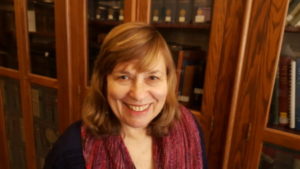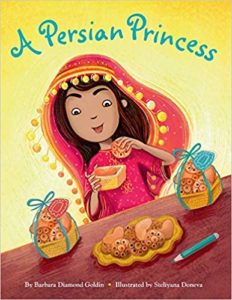Decades ago, Barbara Diamond Goldin started writing children’s stories. Like many new authors, she had an abundance of  rejection letters. Goldin persevered. She listened to editors’ constructive criticism. By paying attention to the world around her, Goldin was able to select engaging topics for future stories. Her award-winning books are found in multiple genres.
rejection letters. Goldin persevered. She listened to editors’ constructive criticism. By paying attention to the world around her, Goldin was able to select engaging topics for future stories. Her award-winning books are found in multiple genres.
Today, I welcome Goldin to my website to share her background, information about her writing style, as well as helpful tips for aspiring writers. Continue reading, if you’d like to know more about Goldin as well as her recent multicultural book, A Persian Princess.
What initiated your interest in writing Jewish children’s books?
When I first started writing seriously, I went to a workshop that mentioned the old adage for writers, “Write what you know.” I grew up in a family that celebrated the Jewish holidays with joy, lots of food, traditions, spirit, and fun. Celebrating the Jewish holidays was something I knew about. Another influence was that my Jewish stories were getting more attention from editors than my other stories.
At the time that I started writing in the late 1980s and 1990s, there was a great need for Jewish children’s stories. My first published stories were in magazines including Highlights. The comments from the editors stated that my stories were too didactic and I should keep trying. Jewish holiday stories were in short supply. I also had two young children and wanted to share stories with them.
For readers unfamiliar with your books, can you provide an overview of the books that you have written and the awards that you have received?
I love doing research. I enjoy writing non-fiction or historical fiction set in different time periods and settings for ages 3-14. My non-fiction book, Meet Me at the Well: The Girls and Women of the Bible, was co-authored by Jane Yolen and published in 2018. Fire: The Beginnings of the Labor Movement was about the Triangle Factory fire and is currently out of print.
I also write picture books. I love the challenge of telling a story for the young audience that inspires and is not didactic. That’s a challenge for me. Examples include— A Persian Princess published in 2020, A Passover Cowboy published in 2017, and The World’s Birthday published in 1990.
I also love doing retellings of inspirational stories, such as I.L. Peretz’s The Magician’s Visit which will be re-published with new illustrations by Green Bean Books of the UK. Another book worth mentioning is The Family Book of Midrash: Fifty-Two Jewish Stories from the Sages.
As for awards, I was honored to receive the Body of Work Award from the Association of Jewish Libraries in 1997. Journeys with Elijah, published in 1999, won the most awards—the Sydney Taylor Book Award Honor Book, A Smithsonian Notable Book for Children, An ALA Notable Children’s Book, A Publishers Weekly Best Children’s Book of 1999, A School Library Journal Best Children’s Book of 1999, A Riverbank Review Children’s Book of Distinction, and An NCSS-CBC Notable Children’s Trade Book in the Field of Social Studies.
For my other book awards, you can check my website at barbaradiamondgoldin.com.
Do you have a favorite genre or age group?
I enjoy writing picture books, retellings, novels for middle grade and younger, and non-fiction. And I like to write essays and articles for adults. I haven’t written anything for the Young Adults audience.
What resources do you use when crafting stories?
I have a large library which is a great resource for inspiration and writing. I also use online resources including “Rabbi Google”, as one of my friends calls it. For instance, I was so excited when I was researching A Persian Princess to find that I could watch the Scroll of Esther chanted in the tomb of Esther and Mordicai in Hamadan, Iran.
I get ideas for stories everywhere. After reading one of I.B. Singer’s stories, I was inspired to write Cakes and Miracles. I listen to conversations in restaurants, trains, and the post office. Other resources include SCBWI and writing magazines, as well as my writing groups.
Did you encounter any challenges in the early stages of your writing career?
My challenges in the early stages of my writing career were typical for writers. One was time. I had two young children. I would write during their naptimes or when I woke up early. Another challenge was the rejection letters. It took five years of rejection letters before I sold my first book, Just Enough Is Plenty to Viking.
I did place many stories in magazines and Jewish newspapers but also received rejections at times from those sources. It was very helpful to work with magazines and newspapers in my early career. I learned a lot from the editors and from researching those stories and articles. The research for my “How to Celebrate Jewish Holidays with Children” articles led to some of my early picture books.
Has your writing style changed since you first started publishing books?
I’m not sure my style has changed. However, changes in the children’s publishing industry have resulted in stories with fewer words, fewer descriptions, and more action. Some of my picture books have been reissued with new illustrations and I’ve cut the text quite a lot.
When Cricket published Cakes and Miracles, the word count was cut in half. That was my first experience in drastically cutting the length of a story. It was a good experience because I saw that I could do it and still like the story. Less word count is the motto of the day for picture books.
Can you share any tips on ways to overcome writers’ block?
I have lots of tips for writers’ block mainly because I use them all the time to avoid it. I don’t worry about writers’ block and don’t even think about it. I’ve built up armor against it. If I get stuck in writing a story, I start at the beginning. I re-read what I have already written when I sit down to write. I sometimes read my research notes if it’s historical fiction. It helps me to think about a story and where I want it to go while I take a walk.
Ideas will often pop up during my sleep. I wake up and write these thoughts on a tablet by my bed. I know I’m old fashioned, but I write my first draft by hand. Somehow the process of physically writing helps me think. Whenever I have an idea, I write it down on the small tablet paper that I keep everywhere – in the car, by my bed, in my purse. That way I have a big pile of ideas, so if I’m starting a new book, I consult all these ideas. It’s wonderful to have that big pile to draw from.
I also read articles in writers’ magazines or read favorite children’s books before I actually write so they get me in the mood for my own writing. I rarely sit down and just start writing. I have these warmups which include re-reading what I’ve written, reading an article by another writer, writing a letter, etc. to get me going.
Where do you find fresh content for your stories?
For fresh content, I still go back to my own library. I also look at what is currently trending online, in magazines, in newspapers, on radio, and TV. Often my editors will give me ideas and tell me what they need. Writing conferences can be a great resource for hearing about what is needed, what is fresh and current. I belong to the Society of Children’s Book Writers and Illustrators and love their conferences.
Can you share three helpful tips for people interested in writing Jewish children’s books?
- Tip 1—With Jewish children’s books and with all children’s books, be careful not to be didactic with information. This can bog down a story and lose the reader’s interest. Capture the spirit and why you’re passionate about writing this story.
- Tip 2—Attend writers’ conferences and read SCBWI magazines and e-newsletters to hear what editors and agents and fellow writers are saying. Check what’s being published, what PJ Library has on its website, to see what the market might need, what holiday is missing, and what Jewish value is missing in Jewish children’s literature.
- Tip 3—Join Jewish Kidlit Mavens on FB, a favorite of mine.
 Why did you decide to write A Persian Princess?
Why did you decide to write A Persian Princess?
My editor at Apples and Honey Press, Ann Koffsky, asked me if I would write a picture book about the Persian Jewish community. She said there were no picture books that she knew of about them and felt there was a need.
After doing some research, I was hooked. I wanted to learn as much about this community as I could and was lucky to find a wonderful source who answered my questions. Her grandparents were from Hamadan. When I learned that Esther and Mordicai’s tomb was there, it seemed perfect to write the book about a Persian Jewish family in the U.S.
What do you hope readers will learn from reading A Persian Princess?
When children read or listen to A Persian Princess, I hope they will understand three things:
- Jews have lived all over the world
- Jews throughout the world celebrate the same holidays but may have different customs.
- Different customs add a richness to everyone’s celebrations.
In 2020, can readers anticipate any new publications?
A Persian Princess, with illustrations by Steliyana Doneva, was published in February 2020 by Apples and Honey Press. In late summer, the same publisher will be introducing a new edition of Night Lights: A Sukkot Story, with illustrations by Amberin Huq. Green Bean Books of the UK has yet to determine the publication date for the new version of The Magician’s Visit, with illustrations by Eva Sanchez Gomez. For updates on upcoming books, check my website— www.barbaradiamondgoldin.com.
Related Blogs
Introduce Purim with the Picture Book— A Persian Princess
Jewish Children’s Favorites—11 Fall Picture Books
Jewish Picture Books for the High Holidays
6 Passover Picture Books—Seders and Rituals
DISCLOSURE
Prior to posting this blog, I was sent a complimentary copy of A Persian Princess.
BIO
Sandra Bornstein is the author of May This Be the Best Year of Your Life. Sandra’s memoir highlights her living and teaching adventure in Bangalore, India. She was a licensed Colorado teacher who taught K-12 students in the United States and abroad as well as college-level courses. In addition to reviewing books and interviewing authors, Sandra is a freelance lifestyle and travel writer. Many of Sandra’s stories appear on the For Readers page. Additional stories can be read on TheTravelingBornsteins website.
Connect with Sandra